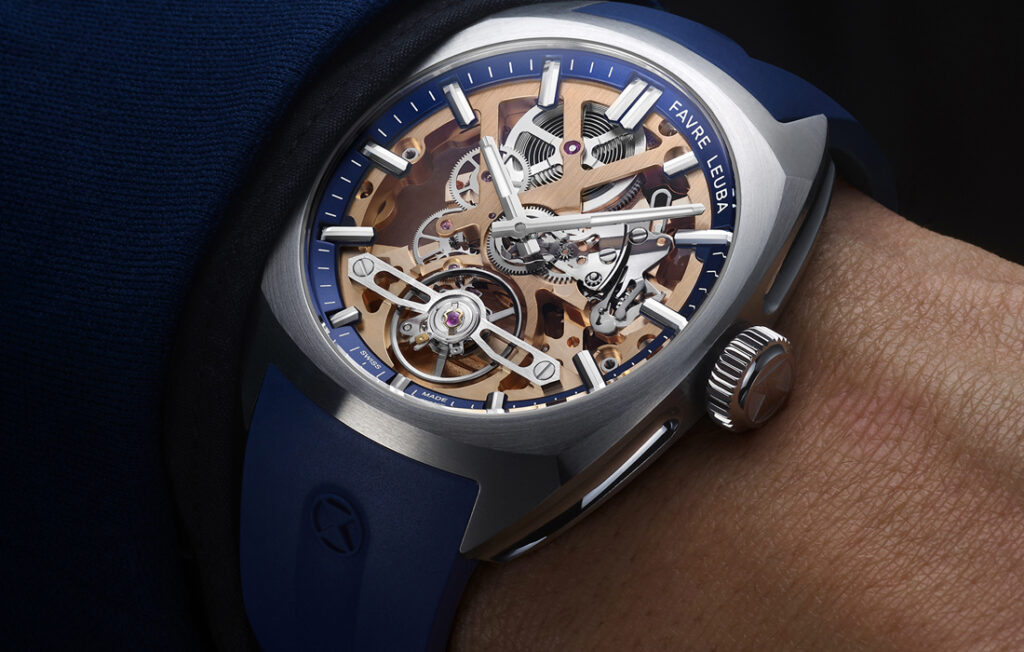Favre Leuba has unveiled the Chief Skeleton, its first skeleton timepiece, fusing nearly three centuries of heritage with modern openworked engineering. Featuring the brand’s signature cushion case and a multi-layer movement architecture, the watch arrives in seven striking variations across gold and DLC-finished movements, marking a bold new chapter for the Swiss maison.

Favre Leuba, the Swiss watchmaker with a legacy stretching back an extraordinary 288 years, has once again proven that history and modernity can coexist in a way that feels both timeless and daring. The brand’s latest debut — its first-ever skeleton timepiece, aptly named the Chief Skeleton — marks a pivotal moment in its evolution. This introduction is not merely the launch of a new watch; it is a bold reimagining of centuries of horological heritage, distilled into a contemporary expression of engineering, aesthetics, and philosophy. For a maison that has lived through revolutions in craft and culture since 1737, the Chief Skeleton is a powerful statement: tradition is not static, and legacy can be forward-looking.
In the increasingly saturated world of luxury timepieces, where brands often rely heavily on archival cues or nostalgia, Favre Leuba instead chooses to interpret history through refinement rather than repetition. The Chief Skeleton draws inspiration from past design codes, especially the signature cushion-shaped case, yet its revelation of technical interiority makes it unlike anything in its preceding portfolio. A skeleton watch is, by definition, intimate — it invites the wearer not just to read time but to observe time being built, regulated, and released. With this model, Favre Leuba takes that intimacy and layers it with architectural depth, creating a spectacle of motion that oscillates between science and art.
The heart of the timepiece is the meticulously openworked movement, where every bridge, wheel, and aperture has been stripped to its aesthetic and mechanical essentials. Skeletonisation, when executed poorly, risks becoming either excessively ornamental or technically compromised. The Chief Skeleton avoids both pitfalls. Instead, it demonstrates the restraint and precision expected from a master manufacturer that has endured nearly three centuries of innovation. The multi-layered architecture of the movement is immediately arresting, offering a sense of depth rather than mere exposure. The eye is drawn first to the semi-exposed mainspring barrel at 12 o’clock — positioned boldly, almost as though time itself is being unspooled before the wearer. Then, at 6 o’clock, the balance wheel provides rhythmic counterpoint, its oscillation serving as the watch’s lifeforce. Together they create a visual symmetry that balances dynamism with structural clarity.
These artistic and mechanical cues are strengthened by the dual variations in which the movement is offered. The first features a radiant gold-finished movement paired with a brushed and polished case. This combination is unmistakably classic, yet it avoids the trap of predictability by allowing the openworked display to introduce a contemporary aesthetic edge. The second variation is darker and more deliberately modern: an anthracite-finished movement housed within a DLC-coated black steel case. This interpretation leans into industrial sophistication, exuding a certain boldness that appeals to an audience seeking a watch that is as much a stylistic proclamation as a precise instrument.
Across both variations, Favre Leuba extends personalization and individuality through an array of dial colours, resulting in seven total expressions of the Chief Skeleton. The gold movement variant comes available with green, blue, and black — three tones that play with the warm metallic finish in entirely different ways. The green offers an elevated richness, the blue brings a refined coolness, and the black draws the eye deeper into the mechanical layers. For the DLC movement, the choices are smoky and striking: black for monochrome minimalism, blue and green for high contrast, and ice blue for a futuristic visual language that has already begun to emerge as a luxury-watch trend in its own right. Each palette variation subtly transforms the character of the timepiece, revealing how colour can influence not just style but the reading of its architecture.
Though aesthetic diversity is part of the collection’s appeal, the core of the Chief Skeleton’s identity is emotional. The very act of skeletonisation removes the boundaries between the wearer and the mechanical pulse beneath the dial. It turns time into a tangible process rather than an abstract function. Every rotation of the gear train, every stored and released molecule of tension, every vibration of the balance is on view. The Chief Skeleton suggests that mechanical horology remains relevant not because it measures time — countless digital devices can do that — but because it materialises the idea of time. In a world increasingly defined by automation and invisibility, the transparency of the watch has philosophical resonance.
Favre Leuba’s decision to unveil its first skeleton timepiece at this point in its journey is more than a design milestone. It signals a deliberate determination to evolve without severing ties to the past. The cushion case anchoring the contemporary architecture speaks to the brand’s heritage, just as the openworked movement speaks to its modern ambitions. This duality reflects the broader paradigm shifts happening within luxury watchmaking: brands must explore fresh identity while retaining the credibility historically earned. The Chief Skeleton does not compromise either side of that equation. It wears its lineage proudly and its innovation unapologetically.
Collectors will take note of multiple dimensions: it is Favre Leuba’s entry into the prestigious category of skeleton watches, but it also represents an accessible embodiment of haute horlogerie values without veering into performative extravagance. Enthusiasts with an eye for detail will likely appreciate the layered bridges, the symmetry of the mechanical layout, and the thoughtful finishing — whether in warm gold-tone or contemporary anthracite. Meanwhile, newcomers drawn visually rather than technically will discover a timepiece that communicates sophistication instantly, even without technical knowledge. In many ways, that is the true genius of the Chief Skeleton: it offers multi-level engagement, democratic yet exclusive.
With this release, Favre Leuba positions itself not merely to honour its storied legacy but to expand it. The Chief Skeleton is a record of endurance — proof that a brand approaching three centuries can still create something that feels new, exciting, and culturally relevant. For collectors who recognise the value of history and the adrenaline of innovation, the watch is more than a product; it is a symbol of rebirth powered not by reinvention, but by evolution.
The Chief Skeleton is not simply a skeletonised watch. It is a modern portrait of Favre Leuba itself — stripped of excess, revealing the core of what has always mattered: precision, craft, and a relationship with time that goes beyond measurement and becomes emotion. As it enters the world in seven distinctive variations, it carries with it the weight of 288 years of horology, now reframed for the present and the future. In the language of watches, the Chief Skeleton speaks fluently — and its message is clear: legacy shines brightest when it dares to evolve.







